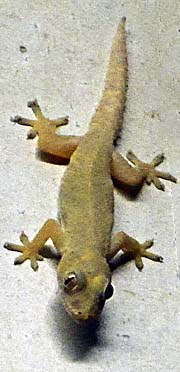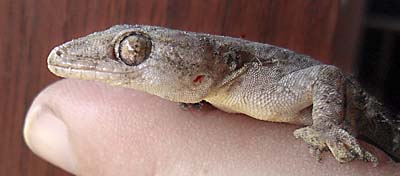1.
Geckos in Southeast Asia
Geckos are a large family of mostly smaller lizards. They live in warmer countries around the globe, particularly in the tropes. About 1,500 species of geckos exist, the largest of them grow up to around 40cm, as the tokay gecko. All the geckos have in common the peculiar ability to climb up walls and windows and can even walk along ceilings in a considerable speed. They are mostly nocturnal and feed from insects as mosquitoes, flies, ants and take advantage of electric light in and around buildings where insects are attracted to.

A gecko on a wall. At dusk they appear here and there, sometimes in small groups around light bulbs. Good to see here are the feet, who occupy more square than it is usually for land animals. This one I have seen in Chiang Khong. It's about 10cm long, tail included. Image by Asienreisender, 2013
The characteristic sound, where the geckos have their name from, comes clearly from the tokay gecko. In countries like Thailand, Laos and Cambodia one can hear the 'ge-koh - ge-koh - ge-koh' often several times a day in rural surroundings. In many places where I personally stayed while travelling Southeast Asia a tokay gecko lived and came out at dusk. The smaller, more common geckos who appear in a larger number utter another noise. It's rather a quiet, chirping sound.
Another peculiarity is that the geckos do not have eyelids. They clean their eyes sometimes with their tongue, what moistens them as well.
When being under attack the geckos can detach their tail. The tail then is still waggling hectically for a while, still showing the stress the animal was under, and maybe distracting the attacking predator from the main body.
Cats love to catch geckos and to eat them. I know a cat which caught a tokay gecko and ate him - only the tail was left. Other potential enemies for the geckos are birds, snakes and other, bigger lizards and rats.
Lizards in general have many teeth. Geckos for example have some 100 teeth, and they fall out and get replaced every three to four months. That reminds to their 'big brother', the crocodile.
Many kinds of geckos are bright and colourful, but the most common geckos in Southeast Asia are not - they are pale and inconspicious.







